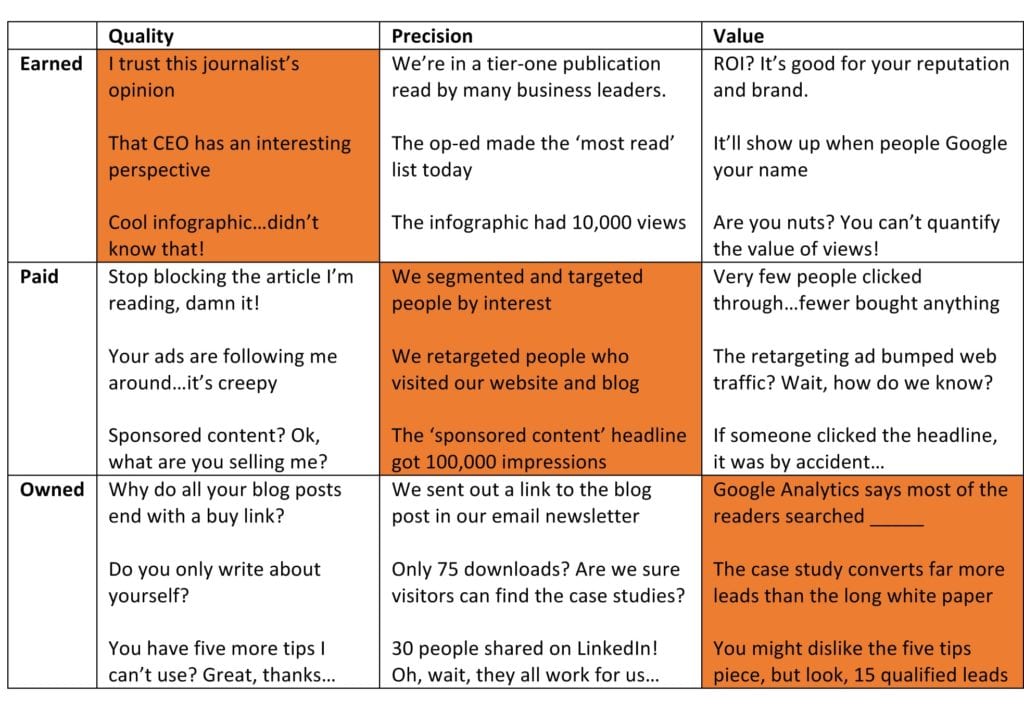
Imagine that a restaurant's menu offers a delicious-looking entree of spaghetti, meatballs and red sauce. Wonderful. Well, sorry, but you are prohibited from ordering them together, on a single plate. Absurd, right? Sounds like a Seinfeld episode.
That is the state of earned, paid and owned media. You can use PR for earned media, digital marketing or advertising for paid media, or content marketing for owned media. But mixing them? Blasphemy.
In reality, separation of media is an illusion. Earned, paid and owned are not types of media but rather are distribution methods. Nothing is preventing you from blending them.
When you combine spaghetti, meatballs, and red sauce, the sum is greater than its parts. The same goes for media. When you earn, pay for and own the same content, you get integrated media.
The Best of Each
Integrated media is an answer to that favorite riddle: What’s the ROI? The purpose is to combine the strengths of earned, paid and owned media into campaigns that maximize quality, precision and measurable value. The chart below illustrates the relative strengths and weakness of each media:

The chart illustrates that earned, paid, and owned media excel in different areas. Earned media wins for quality. People voluntarily seek magazine articles, op-eds, and news segments. Top outlets hold content to a high standard of credibility and newsworthiness. Comparatively, paid and owned media tend to be to spam-ier and more self-promotional.
Paid media is the most precise. With targeting tools like Facebook's, you can segment by affinity, demographics and other data-driven criteria. You can also collect detailed data on how the ads performed. Earned and owned media are more passive and less targeted.
For companies that generate leads or sell online, owned media has measurable value. With Google Analytics, you can determine where visitors came from, how many converted from leads to customers, and what content was most influential in their decision. Earned and paid media lack that tight connection to purchases. Someone who visits an e-commerce site has greater intent to buy a product or service than a person who sees a news article or an ad about it.
The Integrated Approach
Let’s say you sell a high-tech ice pack. Your CEO, Ofer Ichevar, a former Iron Man, Green Beret, Olympic medalist and professional mountaineer invented it. Instead of dividing earned, paid, and owned media, we might integrate them as below:
- Earn: You convince a Wall Street Journal reporter to write about Ofer. “From Green Beret to Ice Pack Innovator” appears in the online version of the publication. It recounts Ofer’s action-filled journey to the perfect ice pack.
- Pay: Normally, you’d run ice pack ads on athletic blogs and mobile health apps. Instead, you use targeting tools on Facebook and Twitter to amplify the WSJ article. In other words, you pay to drive traffic to your earned media because it’s way more compelling and tasteful than your No More Mr. Ice Guy ads.
- Own: Rather than posting yet another blog entry about RICE (rest, ice, compression, and elevation), you post the WSJ article link with an introduction. It’s a mark of credibility – this ice pack is not a scam. After reading about Ofer’s tireless mission to achieve ice pack nirvana, no other ice pack will do. The article might have spent one day on the front page of WSJ.com, but it spends weeks inspiring your blog visitors.
Accountable Marketing
Integrated media works for your brand because it’s good for the audience. The global content machine inundates people with articles, videos and images that they will forget almost immediately. Integrated media reduces clutter while embracing the most advanced tools of digital marketing. It acknowledges that brands should demonstrate and max out their return on investment.
You now can have spaghetti, meatballs and red sauce in one bowl. Earn quality coverage, pay to amplify it, and then own the story. Enjoy!
Heather Kelly is CEO of SSPR
